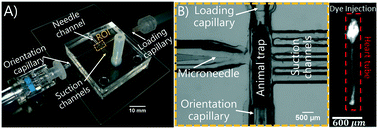Our official English website, www.x-mol.net, welcomes your feedback! (Note: you will need to create a separate account there.)
Localized microinjection of intact Drosophila melanogaster larva to investigate the effect of serotonin on heart rate.
Lab on a Chip ( IF 6.1 ) Pub Date : 2019-12-12 , DOI: 10.1039/c9lc00963a Alireza Zabihihesari 1 , Arthur J Hilliker 2 , Pouya Rezai 1
Lab on a Chip ( IF 6.1 ) Pub Date : 2019-12-12 , DOI: 10.1039/c9lc00963a Alireza Zabihihesari 1 , Arthur J Hilliker 2 , Pouya Rezai 1
Affiliation

|
In this paper, we present a novel hybrid microfluidic device for localized microinjection and heart monitoring of intact Drosophila melanogaster larvae at different developmental stages. Drosophila heart at the larval stage has been used as a model for cardiac disorder studies. However, previous pharmacological and toxicological cardiac studies are limited to dissected (semi-intact) Drosophila larvae which cannot be used for post-treatment studies. Challenges associated with microinjection of intact larvae include delicate handling of individual larvae, proper orientation for microneedle penetration, localized microinjection with controlled amount of chemicals into the hemolymph and reversible immobilization for post-injection phenotypic studies, all addressed by our microfluidic device. Larva loading and orientation were achieved by glass capillaries integrated into the PDMS microfluidic device. Side suction channels were used for immobilization prior to heart activity recording. Localized microinjection was achieved with a one degree-of-freedom microneedle and a custom-made pressure driven reagent delivery system, without any adverse effect on heart rate and animal viability. Precision in localized injection into the body cavity close to the heart chamber or the fat body was demonstrated with our microfluidic device. A MATLAB-based heartbeat quantification technique was used to investigate the dose-dependent effect of serotonin (5-hydroxytryptamine), a neurotransmitter, on the heart rate of intact Drosophila larvae, for the first time. Injection of 40 nL serotonin with ≥0.01 mM concentration significantly increased the heart rate of 3rd instar larvae by 21 ± 7% (SEM). Injection of 5 nL serotonin with a concentration of 0.01 mM significantly increased the heart rate of 2nd instar larvae by 12 ± 3% (SEM). The proposed microfluidic injection and heartbeat monitoring technique can be used for dye angiography and hemolymph circulation studies as well as screening intravenous drugs in vivo using the whole-animal Drosophila melanogaster.
中文翻译:

局部显微注射完整的果蝇果蝇幼虫,以研究5-羟色胺对心率的影响。
在本文中,我们提出了一种新颖的混合型微流控装置,用于在不同发育阶段对完整的果蝇幼虫进行局部显微注射和心脏监测。果蝇幼虫期的心脏已被用作心脏疾病研究的模型。但是,以前的药理和毒理学心脏研究仅限于解剖(半完整)的果蝇幼虫,不能用于治疗后研究。与完整幼体显微注射相关的挑战包括如何对单个幼体进行精细处理,正确定向以实现微针穿透,将局部微量显微注射与可控制数量的化学物质注入血淋巴以及用于可逆固定化的注射后表型研究,所有这些都由我们的微流体装置解决。幼虫的加载和定向是通过将玻璃毛细管整合到PDMS微流控设备中来实现的。在记录心脏活动之前,使用侧吸通道固定。使用一个自由度的微针和定制的压力驱动试剂输送系统实现了局部显微注射,而对心率和动物生存力没有任何不利影响。我们的微流控设备证明了在靠近心腔或脂肪体的体腔中进行局部注射的精度。基于MATLAB的心跳定量技术首次用于研究神经递质5-羟色胺(5-羟色胺)对完整果蝇幼虫心率的剂量依赖性作用。注射40 nL血清素≥0。01 mM浓度可显着提高三龄幼虫的心率21±7%(SEM)。注射浓度为0.01 mM的5 nL血清素可将第二龄幼虫的心率显着提高12±3%(SEM)。拟议的微流体注射和心跳监测技术可用于染料血管造影和血淋巴循环研究,以及使用全动物果蝇(Drosophila melanogaster)体内筛选静脉内药物。
更新日期:2020-02-13
中文翻译:

局部显微注射完整的果蝇果蝇幼虫,以研究5-羟色胺对心率的影响。
在本文中,我们提出了一种新颖的混合型微流控装置,用于在不同发育阶段对完整的果蝇幼虫进行局部显微注射和心脏监测。果蝇幼虫期的心脏已被用作心脏疾病研究的模型。但是,以前的药理和毒理学心脏研究仅限于解剖(半完整)的果蝇幼虫,不能用于治疗后研究。与完整幼体显微注射相关的挑战包括如何对单个幼体进行精细处理,正确定向以实现微针穿透,将局部微量显微注射与可控制数量的化学物质注入血淋巴以及用于可逆固定化的注射后表型研究,所有这些都由我们的微流体装置解决。幼虫的加载和定向是通过将玻璃毛细管整合到PDMS微流控设备中来实现的。在记录心脏活动之前,使用侧吸通道固定。使用一个自由度的微针和定制的压力驱动试剂输送系统实现了局部显微注射,而对心率和动物生存力没有任何不利影响。我们的微流控设备证明了在靠近心腔或脂肪体的体腔中进行局部注射的精度。基于MATLAB的心跳定量技术首次用于研究神经递质5-羟色胺(5-羟色胺)对完整果蝇幼虫心率的剂量依赖性作用。注射40 nL血清素≥0。01 mM浓度可显着提高三龄幼虫的心率21±7%(SEM)。注射浓度为0.01 mM的5 nL血清素可将第二龄幼虫的心率显着提高12±3%(SEM)。拟议的微流体注射和心跳监测技术可用于染料血管造影和血淋巴循环研究,以及使用全动物果蝇(Drosophila melanogaster)体内筛选静脉内药物。


























 京公网安备 11010802027423号
京公网安备 11010802027423号